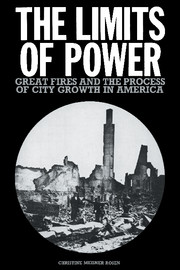Book contents
- Front Matter
- Contents
- List of figures and tables
- Acknowledgments
- Part I The conceptual framework
- 1 Introduction
- 2 The barriers to structural improvement
- 3 The barriers to infrastructural improvement
- 4 The barriers to spatial change
- Part II Three case studies
- Part III Conclusion
- Notes
- Sources of illustrations
- Index
4 - The barriers to spatial change
Published online by Cambridge University Press: 22 September 2009
- Front Matter
- Contents
- List of figures and tables
- Acknowledgments
- Part I The conceptual framework
- 1 Introduction
- 2 The barriers to structural improvement
- 3 The barriers to infrastructural improvement
- 4 The barriers to spatial change
- Part II Three case studies
- Part III Conclusion
- Notes
- Sources of illustrations
- Index
Summary
In addition to compelling the modernization of structures and infrastructures, the multiplication of people and business activity in nineteenth and early twentieth century cities necessitated the reorganization of commercial, industrial, and residential land use patterns. In the early nineteenth century, American cities were little more than small towns, most of their land being given over to compact mixtures of middle class homes, workers' cottages, boardinghouses, stores, artisans' and blacksmiths' shops, saloons and coffee shops, stables, lumber yards, ropewalks, distilleries, and small factories, all within walking distance of one another. Economic and population growth necessitated a reorganization of this mixed pattern of land usage that was as fundamental as the transformation it required of the built environment. The cities were initially so small and geographically undifferentiated that they simply could not physically accommodate the great influx of people flowing into them without undergoing far-reaching spatial redevelopment.
The changes can be summarized as follows. First, population and economic growth required the territorial expansion of the densely built up sections of the cities, together with an overall intensification of land use in these areas. Physically enlarging the areas of dense usage was especially necessary, for without such expansion, growth could be accommodated only through crowding and, in the absence of adequate structures and infrastructures, overcrowding, to the detriment of public health, local business conditions, and the general quality of urban life. Both vertical and horizontal expansion provided relief from the pressures on the land.
- Type
- Chapter
- Information
- The Limits of PowerGreat Fires and the Process of City Growth in America, pp. 68 - 86Publisher: Cambridge University PressPrint publication year: 1986



